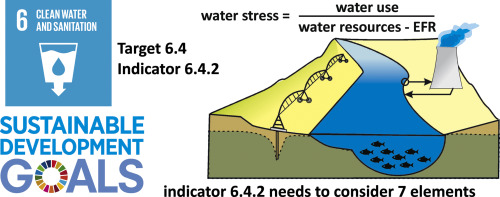当前位置:
X-MOL 学术
›
Sci. Total Environ.
›
论文详情
Our official English website, www.x-mol.net, welcomes your
feedback! (Note: you will need to create a separate account there.)
Physical water scarcity metrics for monitoring progress towards SDG target 6.4: An evaluation of indicator 6.4.2 “Level of water stress”
Science of the Total Environment ( IF 8.2 ) Pub Date : 2017-09-12 , DOI: 10.1016/j.scitotenv.2017.09.056 D. Vanham , A.Y. Hoekstra , Y. Wada , F. Bouraoui , A. de Roo , M.M. Mekonnen , W.J. van de Bund , O. Batelaan , P. Pavelic , W.G.M. Bastiaanssen , M. Kummu , J. Rockström , J. Liu , B. Bisselink , P. Ronco , A. Pistocchi , G. Bidoglio
Science of the Total Environment ( IF 8.2 ) Pub Date : 2017-09-12 , DOI: 10.1016/j.scitotenv.2017.09.056 D. Vanham , A.Y. Hoekstra , Y. Wada , F. Bouraoui , A. de Roo , M.M. Mekonnen , W.J. van de Bund , O. Batelaan , P. Pavelic , W.G.M. Bastiaanssen , M. Kummu , J. Rockström , J. Liu , B. Bisselink , P. Ronco , A. Pistocchi , G. Bidoglio

|
Target 6.4 of the recently adopted Sustainable Development Goals (SDGs) deals with the reduction of water scarcity. To monitor progress towards this target, two indicators are used: Indicator 6.4.1 measuring water use efficiency and 6.4.2 measuring the level of water stress (WS). This paper aims to identify whether the currently proposed indicator 6.4.2 considers the different elements that need to be accounted for in a WS indicator. WS indicators compare water use with water availability. We identify seven essential elements: 1) both gross and net water abstraction (or withdrawal) provide important information to understand WS; 2) WS indicators need to incorporate environmental flow requirements (EFR); 3) temporal and 4) spatial disaggregation is required in a WS assessment; 5) both renewable surface water and groundwater resources, including their interaction, need to be accounted for as renewable water availability; 6) alternative available water resources need to be accounted for as well, like fossil groundwater and desalinated water; 7) WS indicators need to account for water storage in reservoirs, water recycling and managed aquifer recharge. Indicator 6.4.2 considers many of these elements, but there is need for improvement. It is recommended that WS is measured based on net abstraction as well, in addition to currently only measuring WS based on gross abstraction. It does incorporate EFR. Temporal and spatial disaggregation is indeed defined as a goal in more advanced monitoring levels, in which it is also called for a differentiation between surface and groundwater resources. However, regarding element 6 and 7 there are some shortcomings for which we provide recommendations. In addition, indicator 6.4.2 is only one indicator, which monitors blue WS, but does not give information on green or green-blue water scarcity or on water quality. Within the SDG indicator framework, some of these topics are covered with other indicators.
中文翻译:

用于监测实现可持续发展目标6.4进度的实际水资源短缺指标:对指标6.4.2“缺水水平”的评估
最近通过的可持续发展目标(SDG)的目标6.4致力于减少水资源短缺。为了监测实现该目标的进度,使用了两个指标:指标6.4.1测量用水效率,指标6.4.2测量水分胁迫(WS)的水平。本文旨在确定当前提出的指标6.4.2是否考虑了WS指标中需要考虑的不同要素。WS指标比较了用水量和可用水量。我们确定了七个基本要素:1)总水量和净水量(或取水量)均提供了了解WS的重要信息;2)WS指标需要纳入环境流量要求(EFR);WS评估需要3)时间分解和4)空间分解;5)可再生地表水和地下水资源,包括它们的相互作用在内,需要作为可再生水的可利用量加以考虑;6)还应考虑替代性可用水资源,例如化石地下水和淡化水;7)WS指标需要考虑到水库中的水存储,水的循环利用和管理的含水层补给。指标6.4.2考虑了许多这些要素,但有待改进。除了当前仅基于总体抽象来衡量WS之外,建议也基于网络抽象来衡量WS。它确实包含EFR。确实,将时间和空间分类定义为更高级的监视级别的目标,在该级别中,还要求区分地面和地下水资源。然而,关于元素6和7,我们提供了一些缺陷建议。此外,指标6.4.2只是一个监控蓝色WS的指标,但未提供有关绿色或绿色-蓝色水短缺或水质的信息。在可持续发展目标指标框架内,其中一些主题涉及其他指标。
更新日期:2017-09-13
中文翻译:

用于监测实现可持续发展目标6.4进度的实际水资源短缺指标:对指标6.4.2“缺水水平”的评估
最近通过的可持续发展目标(SDG)的目标6.4致力于减少水资源短缺。为了监测实现该目标的进度,使用了两个指标:指标6.4.1测量用水效率,指标6.4.2测量水分胁迫(WS)的水平。本文旨在确定当前提出的指标6.4.2是否考虑了WS指标中需要考虑的不同要素。WS指标比较了用水量和可用水量。我们确定了七个基本要素:1)总水量和净水量(或取水量)均提供了了解WS的重要信息;2)WS指标需要纳入环境流量要求(EFR);WS评估需要3)时间分解和4)空间分解;5)可再生地表水和地下水资源,包括它们的相互作用在内,需要作为可再生水的可利用量加以考虑;6)还应考虑替代性可用水资源,例如化石地下水和淡化水;7)WS指标需要考虑到水库中的水存储,水的循环利用和管理的含水层补给。指标6.4.2考虑了许多这些要素,但有待改进。除了当前仅基于总体抽象来衡量WS之外,建议也基于网络抽象来衡量WS。它确实包含EFR。确实,将时间和空间分类定义为更高级的监视级别的目标,在该级别中,还要求区分地面和地下水资源。然而,关于元素6和7,我们提供了一些缺陷建议。此外,指标6.4.2只是一个监控蓝色WS的指标,但未提供有关绿色或绿色-蓝色水短缺或水质的信息。在可持续发展目标指标框架内,其中一些主题涉及其他指标。











































 京公网安备 11010802027423号
京公网安备 11010802027423号